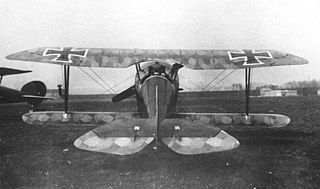
The Sopwith Tabloid and Sopwith Schneider (floatplane) were British biplanes, originally designed as sports aircraft and later adapted for military use. They were among the first successful types to be built by the Sopwith Aviation Company. The "Tabloid", so named because of its small size, caused a sensation when it made its first public appearance.

The Vickers F.B.19 was a British single-seat fighting scout of the First World War, developed from the Barnwell Bullet prototype, and sometimes known as the Vickers Bullet. It served with the Royal Flying Corps and the Imperial Russian Air Service, which subsequently led to the Red Air Force adopting it during the Russian Civil War.

The Blackburn TB was a long-range twin-engined anti-Zeppelin seaplane. It was Blackburn's first multi-engine aircraft to fly.

The Royal Aircraft Factory F.E.8 is a British single-seat fighter of the First World War designed at the Royal Aircraft Factory. It could not escape the drag penalty imposed by its tail structure and was no match for the Albatros fighters of late 1916.

The BAT F.K.23 Bantam was a British single-seat fighter biplane produced by British Aerial Transport Company Limited of London during World War I.
The Short Admiralty Type 74 was a single-engined biplane tractor seaplane with non-folding wings, which saw service with the Royal Naval Air Service during the First World War.

The Bristol T.B.8, or Bristol-Coanda T.B.8 was an early British biplane built by the Bristol Aeroplane Company and designed by the Romanian Henri Coandă. Fifty four Bristol T.B.8s were built, being mainly used as a trainer. A small number of Bristol T.B.8s were briefly used as bombers at the start of the World War I by the Royal Naval Air Service.
The Pemberton-Billing P.B.25 was a First World War British single-seat scout aircraft built by Pemberton-Billing Limited, later Supermarine Aviation Works Limited.
The Sopwith Admiralty Type 807 was a 1910s British biplane seaplane designed and built for the Admiralty by the Sopwith Aviation Company.
The Sopwith Two-Seat Scout was a 1910s British biplane Anti-Zeppelin scout biplane designed and built for the Admiralty by the Sopwith Aviation Company. It was nicknamed the Spinning Jenny due to a tendency to enter a spin.
The Port Victoria P.V.2 was a British prototype floatplane fighter of the First World War, designed and built at the Royal Naval Air Service's Port Victoria Marine Experimental Aircraft Depot on the Isle of Grain. Only a single aircraft was built, with the type not being chosen for production.

The Sikorsky S-10 was a Russian military twin-float seaplane that served with the Russian Navy's Baltic Fleet from the summer of 1913 to 1915. After Igor Sikorsky built the successful Sikorsky S-6 for the Russian military, he tried to build another successful aircraft for them. The S-10 was a modified S-6B built by the Russo-Baltic Carriage Factory. Approximately sixteen production versions of the S-10 were built. It had a less powerful engine and generally weaker structure than the S-6. They had either an 80 hp Gnome Monosoupape or a 100 hp Argus Motoren engine. Some were deployed on the world's first operational seaplane carriers.
The Westland N.1B was a prototype British single-engined floatplane fighter aircraft of the First World War. The first aircraft to be designed by Westland Aircraft, it was a single-engined tractor biplane. Despite good performance, only two aircraft were built, the Royal Naval Air Service operating landplane fighters from ships instead.
The Sage Type 2 was a prototype British two-seat fighter aircraft of the First World War. A single-engined biplane with an enclosed cabin for its crew, only a single example was built, as more advanced aircraft became available.
The Vickers E.F.B.8 was a prototype British twin-engined fighter of the First World War. It was abandoned after only one aircraft was built, single-engined fighters being considered to have superior manoeuvrability.
The Sopwith Sociable was a British single-engined two-seat tractor configuration biplane designed and built by Sopwith for the Royal Naval Air Service.

The Sikorsky S-9Kruglyj was a Russian single engine prototype aircraft completed in the spring of 1913 by the Russian Baltic Railroad Car Works while Igor Sikorsky was the chief engineer of the aircraft manufacturing division.

The Sikorsky S-11 Polukroogly was a Russian single engine prototype reconnaissance aircraft completed in July 1913 by the Russian Baltic Railroad Car Works while Igor Sikorsky was the chief engineer of the aircraft manufacturing division.

The Kondor D 1, given the unofficial name Kondorlaus, was a German single seat, biplane fighter aircraft designed and built close to the end of WWI.
The Vickers Hydravion (No.14) was a British seaplane built by Vickers in the early 1910s.










